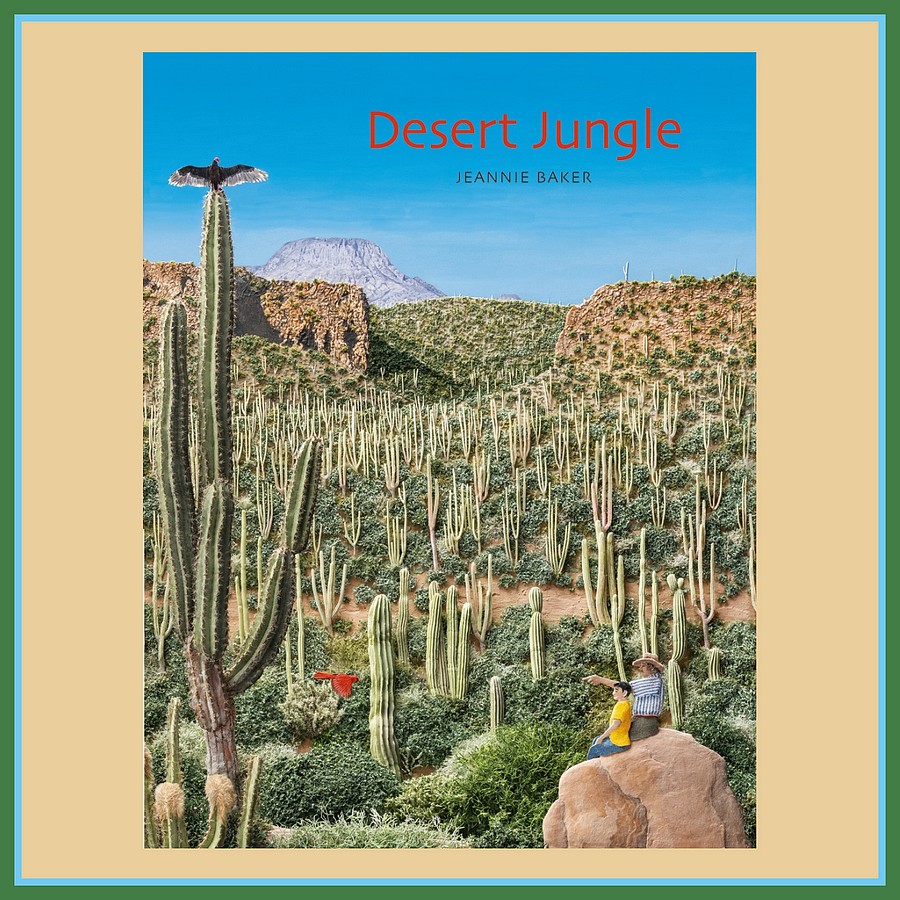
Desert Jungle by esteemed picture book author and artist, Jeannie Baker, is a stunning celebration of a misunderstood desert landscape, rich in diversity as well as a powerful call to action to connect with and protect desert habitats. This story is set in the Sonoran Desert and in the author’s note, Jeannie mentions that “recent studies show deserts, not rainforests, are richest in pollinator diversity”. The biodiversity in the deserts is under extreme threat as there is a lack of understanding about the value in these environments. Jeannie goes on to explains that this book was inspired by a story that was relayed to her while she was on a research trip to the Sonoran Desert. A local told her about their master’s thesis which centred around the lack of knowledge the local children have about their environment and the adverse effects this ignorance has on the children’s connection to their home. The author’s note goes on to discuss Richard Louv’s phrase, Nature Deficit Disorder, coined to describe the costs of a lack of connection to the natural world.
This story follows the transformative journey of a young boy who resides in a desert valley. He spends his days connected to his tablet, oblivious to his natural surroundings. He justifies his unwillingness to explore his environment as he believes there are dangers lurking and these could harm him. This conclusion is drawn from his fears based on what he hears at night.
He visits his Grandpa who is keen to show him the place he grew up, an inviting landscape brimming with cacti, shrubs and mountains, one that would inspire a sense of awe and wonder, pique curiosity if it was observed and appreciated. Instead, the boy opts to engage with his tablet.
The boy wakes to find his bag is missing and because it contains his tablet he is driven to embark on a mission to search for it. He finds himself lost in unfamiliar territory. Inexperienced with the environment, the boy is defensive, he is armed with a stick that he holds in front of him above his head, he is ready to attack and is guarding himself against what he believes to be looming threats.
Minus his tablet, he takes his Grandpa up on his offer to go exploring. He is introduced to amazing plants, each so distinctive including the ocotillo, a shrub with stick like stems and red tubular flowers sprouting from their tips, the fishook cactus that has a thorny top which resembles fishhooks. While exploring, a snake slithers in their vicinity. A threat such as this is not feared by the Grandpa, instead he respectfully does not encroach in the snakes space and quietly comments to his grandson about its beauty. The unprovoked snake causes no harm.
The boy receives many valuable lessons while exploring with his grandpa. Together they observe the plants and animals. With time the boy’s body language is visibly different. Some final parting words from the Grandpa are: “this valley is full of secrets, chico. Opens your heart, listen, and see what wonders show themselves”. These words have a profound influence on the boy and become the impetus for him to take the initiative and further explore. His Grandpa’s words ring true as treasures are indeed discovered.
It’s not all carefree exploring though as the weather abruptly changes and the boy seeks safety in a cave. Here, he alone confronts one of his greatest fears. His Grandpa’s lessons are still fresh in his mind. He needs to apply what he has learnt.
The final double page spreads are glorious and are strong statements highlighting the beauty, wonder and treasures that abound when one does connect with their environment.
The stunning, layered collage illustrations, with magnificent rich details, bring the Sonoran Desert to life and extend the text. There is so much meaning for the reader to interpret and draw from these. The illustrations on the opening page to the final image deftly capture the transformative, full circle journey the boy has undertaken.
This story powerfully conveys that apathy to the natural world causes fear and a lack of respect for it. This fear perpetuates narratives that are misinformed. To resolve this, a connection to the plants, animals and environment is vital, through this a deep appreciation and respect is born.
